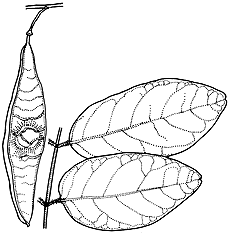Common name: native derris, fish poison vine
Brachypterum involutum (Sprague) Adema & Sirich. APNI* Synonyms: Derris involuta (Sprague) Sprague APNI*

Description: Tall woody climber to forest canopy.
Leaves usually 10–15 cm long; leaflets 9–13, ovate to elliptic or oblong, 1.8–5.5 cm long, 13–35 mm wide, apex usually obtuse, margins entire, upper surface sparsely hairy,glabrescent, lower surface sparsely rusty-hairy; petiole 3–6 cm long; lateral petiolules 2–3 mm long.
Racemes axillary or terminal, 5–25 cm long; pedicels c. 5 mm long. Corolla 10–12 mm long, white and purple.
Pod 4.5–9.5 cm long, 11–15 mm wide, wing on upper suture 1–2.5 mm wide; seeds 1–3.
Flowering: November–December. Fruiting March-August.
Distribution and occurrence: Occurs north from Cresent Head. Gows in in vineforest, rainforest, vine thicket, wet sclerophyll forest, eucalypt woodland and open forest.
NSW subdivisions: NC
Other Australian states: Qld
Previously included in either Derris or Solori. Historically included in Wisteria.
Text by R.L. Barrett, March 2025
Taxon concept: Cooper WE et al. (2024) A revision of Derris and Brachypterum (Leguminosae subfamily Papilionoideae) in Australia. Australian Systematic Botany 37, SB23030. doi:10.1071/SB23030
APNI* Provides a link to the Australian Plant Name Index (hosted by the Australian National Botanic Gardens) for comprehensive bibliographic data
***The AVH map option provides a detailed interactive Australia wide distribution map drawn from collections held by all major Australian herbaria participating in the Australian Virtual Herbarium project.
|


